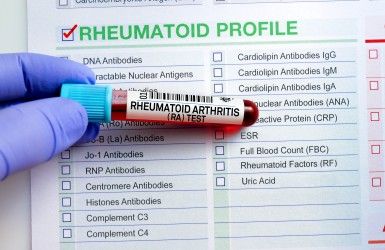General Health
RA Factor Test – Normal Range, Purpose, Procedure, and Results Interpretation
5 min read
By Apollo 24|7, Published on - 21 May 2025
Share this article
0
0 like

The RA factor test, also known as the rheumatoid factor test, is a diagnostic blood test used primarily to detect rheumatoid arthritis (RA) and other autoimmune conditions. Rheumatoid factor (RF) is an autoantibody—an immune protein that mistakenly targets the body's own tissues. Elevated RF levels may indicate that the immune system is attacking healthy cells, a hallmark of autoimmune disorders. This test is often one of the first steps when a patient presents with joint pain, stiffness, or swelling, especially when symptoms are persistent or symmetrical (affecting the same joints on both sides of the body). It plays an important role in helping clinicians assess disease activity, confirm a diagnosis, and determine the best treatment path. The RA factor test is especially valuable in identifying early disease, where intervention can significantly improve outcomes and prevent joint damage and disability.
Purpose of the RA Factor Test
The RA factor test serves several important purposes:
1. Diagnosis of Rheumatoid Arthritis
The most common reason for ordering an RA factor test is to evaluate for rheumatoid arthritis, a chronic inflammatory disorder affecting joints and, in some cases, other organs.
2. Identifying Other Autoimmune Disorders
Elevated RF levels may also indicate:
- Sjogren’s syndrome – often involves dry eyes and mouth
- Systemic lupus erythematosus (SLE)
- Scleroderma
- Chronic infections such as hepatitis B or C, tuberculosis, and endocarditis
3. Differentiating RA from Other Conditions
Joint pain can result from many causes, including osteoarthritis, gout, psoriatic arthritis, or mechanical injuries. The RA factor test helps narrow down the possible causes when evaluating symptoms.
4. Monitoring Disease Activity
In patients already diagnosed with RA, the RA factor test may occasionally be repeated to track disease progression, although more specific markers like CRP and ESR are often used for that purpose.
How to Prepare for an RA Factor Test?
Preparation Steps:
- No fasting is required for an RA factor test.
- You may continue to take all prescribed medications unless advised otherwise.
- Inform your provider about any recent illnesses, vaccinations, or ongoing infections, as these may influence your immune response.
- Let your healthcare provider know if you are pregnant or have any history of autoimmune disease in your family.
- Keeping your provider informed ensures your test is interpreted accurately in the context of your overall health.
Procedure for RA Factor Test
The RA factor test is a standard blood test performed at a clinic, hospital, or diagnostic lab.
What to Expect:
- A healthcare professional will apply an antiseptic to your skin and place a tourniquet around your arm.
- A small needle is inserted into a vein (usually the inside of your elbow), and blood is drawn into a collection tube.
- After the sample is collected, a cotton ball and bandage are applied to stop any bleeding.
- The sample is then sent to a lab for testing.
- The procedure usually takes 5 to 10 minutes. Minor discomfort or bruising at the puncture site is common but temporary.
RA Factor Test: Results Interpretation
How RA Factor Results Are Reported:
- Results are measured in international units per milliliter (IU/mL).
- Labs use reference ranges to determine whether your level is within the normal, borderline, or elevated range.
Interpreting the Results:
- Negative or Normal Result: Typically means RA factor is not present or is below the threshold (usually <14 IU/mL). However, a negative test does not rule out RA entirely.
- Positive or Elevated Result: Indicates the presence of RA factor above the normal threshold and may suggest autoimmune activity.
Because elevated RA factor levels can occur in conditions other than RA—and even in some healthy individuals—your doctor will interpret the result alongside your symptoms, exam findings, and other blood tests.
RA Factor Test Normal Ranges
Most laboratories consider less than 14 IU/mL to be within the normal range for rheumatoid factor. However, exact cut-off values can vary slightly depending on the testing method.
RA Factor Normal Range in Female Patients
The RA factor normal range in females is generally the same as in males—<14 IU/mL. However, interpretation can be influenced by:
- Age: Older women may have slightly elevated RA factor without any clinical disease.
- Hormonal changes: Shifts during menstruation, pregnancy, or menopause may affect immune responses.
- Family history: A family history of autoimmune diseases can predispose women to test positive, even in the absence of symptoms.
Because women are two to three times more likely to develop RA than men, clinicians often consider RF results more carefully in female patients, especially those with symptoms such as joint swelling, fatigue, or systemic inflammation.
Abnormal RA Factor Levels
A positive RA factor test may indicate:
- Rheumatoid arthritis
- Sjogren’s syndrome
- Systemic lupus erythematosus (SLE)
- Scleroderma
- Chronic liver infections such as hepatitis B or C
- Infective endocarditis
- Tuberculosis
- Certain cancers like leukemia or multiple myeloma
Important Notes:
- Not everyone with a positive RA factor has rheumatoid arthritis.
- Around 10–20% of healthy older adults may have a mildly elevated RA factor with no disease.
- Conversely, seronegative RA refers to cases where the RA factor is not present, yet clinical and radiographic evidence confirms the diagnosis.
Managing Abnormal RA Factor Test Results
If You Test Positive:
- Additional Testing: Your provider may order anti-CCP, ANA, CRP, ESR, or imaging like X-rays or MRI to look for joint damage or inflammation.
- Specialist Referral: A rheumatologist may be consulted for comprehensive evaluation.
- Initiating Treatment: If diagnosed with RA, early treatment can reduce joint damage and prevent complications.
- Monitoring for Disease Progression: Patients with a positive RA factor but no active symptoms may be monitored periodically.
Treatment Options May Include:
- DMARDs (e.g., methotrexate)
- Biologic agents (e.g., TNF inhibitors)
- NSAIDs and steroids for inflammation
- Lifestyle modifications, including exercise and anti-inflammatory diets
Conclusion
The RA factor test is a valuable and accessible tool for diagnosing autoimmune diseases, particularly rheumatoid arthritis. Understanding your test result in the context of your symptoms, age, gender, and other diagnostic tests is essential for accurate interpretation and timely treatment. For female patients, awareness of the RA factor normal range in females—along with the knowledge that immune function can be influenced by hormonal and age-related changes—is vital. Whether your test result is within the normal range of RA factor in female patients or elevated, collaboration with your healthcare team ensures the most
General Health
Frequently Asked Questions
Is a positive RA factor test result a definitive diagnosis of rheumatoid arthritis?
Is a positive RA factor test result a definitive diagnosis of rheumatoid arthritis?
Can I have rheumatoid arthritis with a negative RA factor?
Can I have rheumatoid arthritis with a negative RA factor?
Is the RA factor test painful?
Is the RA factor test painful?
Can infections affect my RA factor levels?
Can infections affect my RA factor levels?
How long does it take to get RA factor test results?
How long does it take to get RA factor test results?
What is the RA factor normal range for females?
What is the RA factor normal range for females?
Is the normal range of RA factor in females different from that in males?
Is the normal range of RA factor in females different from that in males?
Can RA factor levels change over time?
Can RA factor levels change over time?
Does a high RA factor mean I definitely have RA?
Does a high RA factor mean I definitely have RA?
Can you have a normal RA factor and still require treatment?
Can you have a normal RA factor and still require treatment?
Leave Comment
Recommended for you

General Health
How To Prevent Hearing Loss?
Hearing loss can be slow. However, if it goes unnoticed for a long period, the person may experience difficulty in communicating with others, which may result in poor quality of life.
.jpg?tr=q-80)
General Health
Serum Creatinine Test: Interpreting Normal and Abnormal Ranges

General Health
Green Tea VS Black Tea: Is It That Difficult To Pick The Side?
While green tea lowers cholesterol levels, black tea has anti-inflammatory properties. Read to know more about the benefits of both the tea.
Subscribe
Sign up for our free Health Library Daily Newsletter
Get doctor-approved health tips, news, and more.
Visual Stories

The Best Exercises for Controlling Blood Sugar Levels
Tap to continue exploring
Recommended for you

General Health
How To Prevent Hearing Loss?
Hearing loss can be slow. However, if it goes unnoticed for a long period, the person may experience difficulty in communicating with others, which may result in poor quality of life.
.jpg?tr=q-80)
General Health
Serum Creatinine Test: Interpreting Normal and Abnormal Ranges

General Health
Green Tea VS Black Tea: Is It That Difficult To Pick The Side?
While green tea lowers cholesterol levels, black tea has anti-inflammatory properties. Read to know more about the benefits of both the tea.